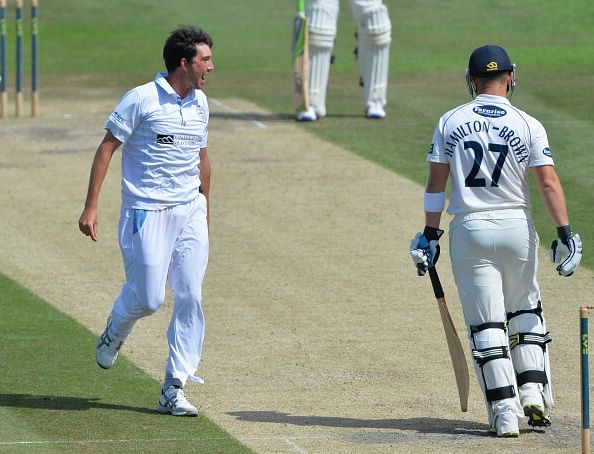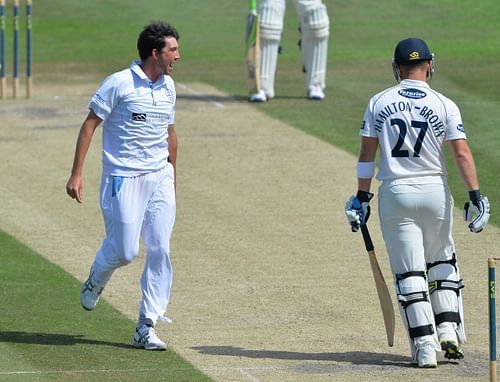
Mark Footitt - The case for England

There was a time, back in the early days of this blog, when the mention of Mark Footitt's name brought forth a veritable postbag of responses.
He wasn't that fast, said people who hadn't faced him at 22 yards. He was unfit. He was erratic. He was a liability. He was a Nottinghamshire reject. As is the way with life, people - supporters, mind - were quick to focus on what he couldn't do, rather than look at, and be grateful for what he could do.
That, in Mark's case, has always been to propel a cricket ball down 22 yards as quickly as anyone in the country. No one ever doubted that, but this very rare talent was subsumed beneath plenty of counter arguments. Few wanted him in a limited-overs side because he could go all over the place. There was a time when his wicket-keeper du jour was probably glad of his omission too, saving full length dives to leg and off in the vain hope of stopping the more than occasional wild one, when his action let him down and the ball became cannon fodder for the batsman - assuming he could reach it.
Having made his debut in 2005 at Trent Bridge, he got to the end of the 2012 season with 72 wickets to show for seven seasons in the first-class game. It was a poor return and a reflection on perhaps an equally poor level of fitness. He was far from an automatic choice in a Derbyshire side that won promotion that summer when Footitt took only eleven wickets.
At the end of that season, he had an operation to remove a disc from his back that was pressing on either a nerve or his spinal cord. There was a chance that he might never play again, but thanks to the skill of the surgeon, together with that of James Pipe, the Derbyshire physio, he was ready for Derbyshire's summer in the top tier with an improved level of fitness and a stronger 'core' that enabled him to bowl fast for longer spells.
He took 42 wickets that summer, looking like our best bowler in a campaign where we started dreadfully slowly and were ultimately relegated, despite a late-season surge that saw unlikely victories. He showed he could trouble batsmen at that level, as well as get them out.
Then came 2013. It was the year when his body was fully repaired, his action more grooved and his run up became smooth and awe-inspiring. There was no coincidence in that it was Graeme Welch's first summer in charge, a man with an impressive reputation as a coach of seam bowlers.
Footitt troubled everyone and dismissed many. Several players headed for the local emergency rooms after being hit on the head or body by bowling that was simply too quick for them. Australian Michael Klinger was one, his forearm broken by a quick, rising delivery in a one-day game where Footitt was the difference between the sides.
For the first time in many years, we had a weapon to top and tail an innings. He was simply too quick for some opening batsmen with the hard new ball, as well as remaining so for nine, ten, jack, some of who showed less than willing to get behind a ball coming from a fast left-arm bowler.
Therein lies his real value. The game has had very few genuine fast bowlers of the left-arm variety. Wasim Akram, Dirk Nannes, Mitchell Johnson, perhaps Sobers on an occasional delivery, but that's it. New Zealander Trent Boult showed the value of that pace and angle in the recent World Cup while England chose to tour South Africa with their Lions side without Footitt, who attended pre-tour nets.
The South Africans in turn made hay while the sun shone against an array of right-arm seamers of similar pace and style. Much as England suffered in the World Cup for the Stepford Wives cloning of an attack, as those of us in the know back home muttered oaths about selectorial sanity, bias and inadequacy.
He took 106 wickets in all competitions in 2013. No one else came close to that. Presumably those in the corridors of power wrote it off as a fluke, unlikely as it is that someone could be so prolific with luck alone as a weapon.
2015 has begun with more of the same. Twelve wickets in his first two matches, the second played on a wicket that became increasingly slow and moribund. In the second innings, he bowled more overs than anyone, 34 in total and took six wickets.
Throughout he sustained a high level of pace, whether bowling over or around the wicket. He was and is a constant threat. His captain, Wayne Madsen, admitted afterwards that the wicket-keeper and slips stood several yards deeper for him, so quickly was he still coming through at the end of the innings.
Of course, if England continue to ignore him, it will be to Derbyshire's benefit. Any attack with him in it is all the stronger and those of us who have watched him over the past two summers are convinced that his time is now. At 29, he is fast, fit and firing, his body strong and his talent undeniable. He may be playing in division two, but he's dismissed enough talented players, including overseas batsmen, to confirm he could stand easily alongside the best.
He should play against New Zealand this summer, although opportunity to blood him was missed in the Caribbean. Like Mitchell Johnson, he can be considered a late developer, but like Johnson, one takes the rough with the smooth. He might go for a few boundaries against a batsman prepared to chance his arm, but he could equally easily blow away a top order in a short, sharp spell.
If there's any justice, common sense or, indeed sanity in English cricket selection, Mark will get an international opportunity this summer. If he doesn't, the consolation prize will be that he will spearhead the Derbyshire attack in a strong challenge for a return to the top tier.
Is that over-confident? Not really. I've watched him bowl often enough to justify it.
We love him to bits at Derbyshire. The wild tyro has become a class act.